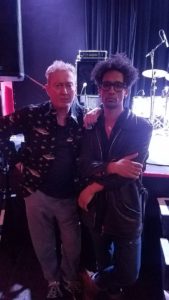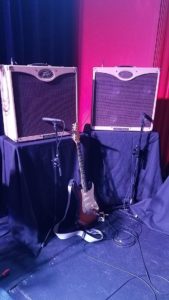
Above Photo: Andy Gill (at left) with bassist Thomas McNeice after Gang of Four soundchecked before the band’s February 9, 2019 performance at The Chapel, San Francisco.
Sadly and unexpectedly, the funky and innovative Gang of Four guitarist Andy Gill passed away in London following a short illness on February 1, 2020. Gill was just 64 years old, and reportedly was listening to album mixes and plotting the band’s next tour from his hospital bed almost to the moment he died. Most definitely a Guardian of Guitar and a warrior right to the end.
I talked to Gill and bassist Thomas McNeice almost a year ago (February 9, 2019) right after their soundcheck, and just before the band’s sold-out performance at The Chapel in San Francisco. Although time is usually tight between gear setup and a band’s “curtain up” call, Gill was upbeat, appeared unhurried, and was happy to discuss his rig and stylistic approach while still standing onstage. (Someone did bring him a beer as we talked, so that may have helped.) The band was touring to promote its new album, Happy Now, where Gill had opted to work with co-producers, even though his own command of production techniques was legendary. The already supportive and besotted Chapel audience was loud, boisterous, and ecstatic, cheering to every jagged lick and groove-o-licious vamp. Gill’s rhythm work was razor sharp—an amalgam of catchy riffs, militaristic accents, and sharp melodies, and his solos were concise yet sonically expansive and thrilling. It was a masterful show, and Gill still seemed excited to perform for fans, even though he had logged 43 years of treading stages all over the world. He will be missed.
I hadn’t even planned to go to the show, in fact. But my wife is a Gang of Four fan and she wanted to see the band, so I asked my colleague, Jon D’Auria, of Bass Magazine for a contact, and, thanks to Jon and Gang of Four tour manager and backline tech Matt Manning, I was scheduled to talk with Gill and McNeice. Obviously, I was glad I saw the show, and I’m happy to have this interview with Gill to share…
So how does this all routing I’m seeing work for Andy’s guitar sound?
Matt Manning (tech): Andy’s guitar goes into a tuner, which then runs into a splitter that goes to two audio interfaces. We control all the guitar sounds using plug-ins in Apple MainStage 3. We have two amps and two direct signals, both in stereo, to blend tones together, so the guitar sound is massive. I’m following the set list and controlling the guitar-sim patches and effects on the laptop. It’s something we couldn’t do with pedals because of how many plug-ins Andy uses. In fact, while recording Happy Now, Andy went direct—he didn’t use amps—so the great thing about this system is we can take the exact guitar sounds he used in the studio out on the road with us. We also run A and B rigs, so if one goes down, I can switch to the backup rig.

Above Photo: The routing system from the stage splits Gill’s mono guitar signal to two audio interfaces that feed MainStage3 for amp simulations, stereo Peavey Classic 50 amps, and stereo direct signals.
So what audio comes out of the two Peavey Classic 50 amps—the natural amp sound, or the signal from the amp simulators?
Andy Gill: There are various amp simulators in the chain that come from the laptop, and these are sent to the two Peavey Classic 50 amps, which I keep on the Normal [clean] channel, unless I want some overdrive for solos or something, in which case, I’ll switch to the Lead channel. The audience hears a mixture of the two Peaveys and the direct signal signal from the laptop.
Manning: Because we are using amp simulators, we can emulate every guitar tone from the band’s entire history. So if Andy is playing something from Entertainment! [1979], we can give the audience more or less the exact guitar sound they heard on the original album.

Above Photo: Gill’s two Peavey Classic 50 amps and his Fender Stratocaster.
You’ve produced a lot of albums throughout your career. What was the thought behind making Happy Now with three co-producers?
Gill: I didn’t want to do everything myself, as I have done on many occasions in the past. I wanted to have another sort of producer’s head in the mix, and I thought having other people to move things along would bring more momentum to the project. And it did. During the project, I went through a phase of getting up at 6 am, drinking a cup of tea in the dark, and working on things. Then, whichever co-producer was helping with a particular track—Ben Hillier, Catherine Mayer, or Ross Orton—would come in a few hours later. I’d nod off for a bit [laughs], and we’d still get a full day’s work in. So we got an awful lot done, an awful lot done quickly, and the momentum never faltered.
How did you and the co-producers build the tracks?
Gill: Basically, we’d go back and forth over the pieces. There’s always a different way of doing things, you know? Someone might say, “Oh, hello—we could do this?” And that idea would lead to an alternative I hadn’t though of—hopefully, one that can make everybody happy. We also mapped everything out fairly carefully in order to have an arrangement template for each song.
Even considering the collaborative aspect of the production process, did you have certain elements you championed?
Gill: I might have said I wanted this record to be danceable and poppy [laughs]. Well, maybe I just wanted the album to be accessible, rather than difficult. I also did not want a predefined palette so we could try different sounds without worrying about any Gang of Four legacy. As things came along, we’d just take everything at face value. For example, when we started the record, I was into a lot of the electronics you hear on trap [hip-hop] music—that wobbly stuff. I even said, “Let’s leave some holes in the bass lines, so we can add in some electronic stuff.”
McNeice: A lot of things happened through trial and error, or by accident or instinct.
How do you typically approach your guitar riffs?
Gill: The guitar riff has to absolutely lock in with the bass and drums. But then it can go completely off on other parts. Sometimes, that means adding and constructing, and, sometimes, it means being anarchic and destroying. For a lot of licks, I like to incorporate borderline feedback—meaning the sound sustains until the next note, but doesn’t go out of control. Those sustained harmonics are part of the riff, and they are really important in some songs. To get there, we actually spend a lot of time fiddling with the settings. You don’t want a load of buzzing or over-saturated gain.
Your style is so unique and singular. Could you provide a bit of insight into how you developed that style?
Gill: When I was 13, it was nothing but Jimi Hendrix. Then, a little bit later, I became attracted to the Velvet Underground. Their use of feedback was similar to what Hendrix did, but different. Eventually, I went to the other extreme by listening to late-’60s and early-’70s music from Stax Records. Steve Cropper [Stax session guitarist] is funky and he knows his chords. I’ve always considered Steve to be the great-grandfather of Nile Rogers. Of course, I was also influenced by Keith Richards and his very economical, riff-driven playing. Wilco Johnson, as well—he’s such a genius robotic rhythm player. So, it was more about opposites for me. The fluid feedback-y thing came from Hendrix and the Velvet Underground, and I kind of blended it with the opposite style of this very precise rhythmic picking and strumming.
How would you define the Gang of Four sound throughout the past 40 years?
Gill: I’ve always approached Gang of Four’s music fundamentally the same. It’s just the guitar, bass, drums, and vocals sitting next to each other and working with each other in a kind of matrix, rather than layering parts on top of each other. We lock into each other, and the rhythm is carefully thought out so that it’s funky and exciting.
It’s almost miraculous how huge the records sound, considering Gang of Four typically uses so little in the way of sonic textures. It’s very simple in a way that conflicts with some modern concepts of audio production that are far more complex and intricate.
McNeice: I think how it works for us is that, for a lot of Gang of Four songs , every element is a signature part that stands on its own. The drums have a unique signature drum beat, which you don’t often hear. It’s not just the usual four-on-the-floor groove—it’s something you can remember. We go for a signature bass line that’s catchy, and the guitar, of course, is very distinctive and special. All of these parts work together to create something that’s creative and memorable with a massive dynamic impact.
Gill: I like that you said “simple,” because, sometimes, I worry if our records are simple enough. I mean, when you hear a Muddy Waters’ record, he’s in a room tapping his foot on the floor, and you hear him kicking his guitar, and you hear his voice. What could be simpler than that? But that sound is so thrilling, and it is my touchstone. If I’m layering stuff, I’m going wrong.




